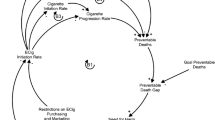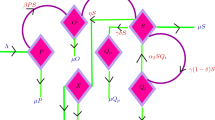Abstract
Cigarette smoking on college campuses has become a significant public health issue, which in turn led to an increasing focus on establishing programs to reduce its prevalence. In this paper, a compartmental model depicting the spread and cessation of the smoking habit on college campuses, obtained using theoretical principles often employed in mathematical epidemiology, is proposed and analysed. The existence and stability of the habitual smoking-free and habitual smoking-persistent equilibria, respectively, are explored in terms of a threshold parameter, hereby called the smokers generation number and denoted by \(R_c\). A sensitivity analysis indicates that \(R_c\) is the most sensitive to the contact rate between habitual-smokers and occasional-smokers and to the rate of successfully quitting smoking. Numerical simulations of the proposed optimal control strategies reveal that the most effective approach to reduce the prevalence of cigarette smoking and possibly achieve a smoking-free campus should combine both control measures, namely allocating mandatory smoking rooms together with educating the public on the harmful effects of smoking and providing large scale guidance, counselling and support therapy to help students quit smoking.









Similar content being viewed by others
References
Laud, A.D.J., Marian, F.: The threats of globalization on global public health with specific reference to tobacco control. Public Health Res. 6(5), 132–142 (2016). https://doi.org/10.5923/j.phr.20160605.02
U.S. Department of Health and Human Services: The Health Consequences of Smoking—50 Years of Progress: A Report of the Surgeon General. Atlanta: U.S. Department of Health and Human Services, Centers for Disease Control and Prevention, National Center for Chronic Disease Prevention and Health Promotion, Office on Smoking and Health (2014). (Accessed 21 Feb 2018)
World Health Organization: WHO Report on the Global Tobacco Epidemic. World Health Organization, Geneva (2011). (Accessed 22 Feb 2018)
World Tobacco Production By Country | Statista. https://www.statista.com/statistics/261173/leading-countries-in-tobacco-producti. (Accessed 2 Oct 2018)
The 14th World Conference on Tobacco or Health (WCTOH) (2014). http://www.who.int/tobacco/wctoh/en/
Chinese Students Begin To Smoke At A Younger Age (2011). http://www.chinatoday.com.cn/ctenglish/se/txt/2011-09/28/content_394307.htm. (Accessed 02 Oct 2018)
Most Chinese Colleges Fail In Tobacco Control. http://www.chinatoday.com.cn/ctenglish/se/txt/2011-09/28/content_394298.htm. (Accessed 02 Oct 2018)
Results from the 2013 National Survey on Drug Use and Health: Summary of National Findings. https://www.samhsa.gov/data/sites/default/files/NSDUHresultsPDFWHTML2013/Web/NSDUHresults2013.pdf
Levinson, A.H., Campo, S., Gascoigne, J., Jolly, O., Zakharyan, A., Tran, Z.V.: Smoking, but not smokers: identity among college students who smoke cigarettes. Nicotine Tob. Res. 9(8), 845–852 (2007)
Philpot, S.J., Ryan, S.A., Torre, L.E., Wilcox, H.M., Jalleh, G., Jamrozik, K.: Effect of smoke-free policies on the behaviour of social smokers. Tob. Control 8, 278–281 (1999)
Gilpin, E.A., White, V.M., Pierce, J.P.: How effective are tobacco industry bar and club marketing efforts in reaching young adults? Tob. Control 14, 186–192 (2005)
Moran, S., Wechsler, H., Rigotti, N.A.: Social smoking among US college students. Pediatrics 114, 1028–1034 (2004)
Colder, C.R., Lloyd-Richardson, E.E., Flaherty, B.P., Hedeker, D., Segawa, E., Flay, B.R.: The natural history of college smoking: trajectories of daily smoking during the freshman year. Addict. Behav. 31, 2212–2222 (2006)
Smoke & Tobacco Free Campus: Supporting College Student Health. https://www.affordablecollegesonline.org/college-resource-center/tobacco-free-co. (Accessed 05 Oct 2018)
Zhang, H., Harvim, P., Georgescu, P.: Preventing the spread of schistosomiasis in Ghana: possible outcomes of integrated optimal control strategies. J. Biol. Syst. 25(4), 625–655 (2017)
Okosun, O., Rachid, O., Nizar, M.: Optimal control strategies and cost-effectiveness analysis of a malaria model. BioSystems 111, 83–101 (2013)
Castillo-Chavez, C., Song, B.: Dynamical models of tuberculosis and their applications. Math. Biosci. Eng. 1(2), 361–404 (2004)
Amdouni, B., Paredes, M., Kribs-Zaleta, C., Mubayi, A.: Why do students quit school? Implications from a dynamical modelling study. Proc. R. Soc. A (2017). https://doi.org/10.1098/rspa.2016.0204
Nyabadza, F., Ogbogbo, C.P., Mushanyu, J.: Modelling the role of correctional services on gangs: insights through a mathematical model. R. Soc. Open Sci. 4, 170511 (2017). https://doi.org/10.1098/rsos.170511
Castillo-Garsow, C., Jordan-Salivia, G., Herrera, A.R.: Mathematical Models for the Dynamics of Tobacco Use, Recovery, and Relapse, Technical Report Series BU-1505-M. Cornell University, Ithaca (1997)
Sharomi, O., Gumel, A.B.: Curtailing smoking dynamics: a mathematical modeling approach. Appl. Math. Comput. 195(2), 475–499 (2008)
Lahrouz, A., Omari, L., Kiouach, D., Belmaâti, A.: Deterministic and stochastic stability of a mathematical model of smoking. Stat. Probab. Lett. 81(8), 1276–1284 (2011)
Zaman, G.: Qualitative behavior of giving up smoking models. Bull. Malays. Math. Sci. Soc. 34(2), 403–415 (2011)
Zaman, G.: Optimal campaign in the smoking dynamics. Comput. Math. Methods Med. 2011, Article ID 163834, 9 p (2011)
Ertürk, V.S., Zaman, G., Momani, S.: A numeric-analytic method for approximating a giving up smoking model containing fractional derivatives. Comput. Math. Appl. 64(10), 3065–3074 (2012)
Zhang, Q., Luo, Y.H., Zhang, X.H., Wang, Y.: The relationship among school safety, school satisfaction, and students’cigarette smoking: based on a multilevel mediation model. Child Youth Serv. Rev. 88, 96–102 (2018)
East, K., Hitchman, S.C., Bakolis, I., Williams, S., Cheeseman, H., Arnott, D., McNeill, A.: The association between smoking and electronic cigarette use in a cohort of young people 2017. J. Adolesc. Health 62(5), 539–547 (2017)
Doran, N., Brikmanis, K., Petersen, A., Delucchi, K., Al-Delaimy, W.K., Luczak, S., Myers, M., Strong, D.: Does e-cigarette use predict cigarette escalation? A longitudinal study of young adult non-daily smokers. Prev. Med. 100, 279–284 (2017)
Choi, W.S., Gilpin, E.A., Farkas, A.J., Pierce, J.P.: Determining the probability of future smoking among adolescents. Addiction 96(2), 313–323 (2001)
Krugman, D.M.: Understanding the impact that marketing, advertising, and promotion have on adolescent E-cigarette behavior. J. Adolesc. Health 59(6), 609 (2016)
Van den Driessche, P., Watmough, J.: Reproduction numbers and sub-threshold endemic equilibria for compartmental models of disease transmission. Math. Biosci. 180, 29–48 (2002). https://doi.org/10.1016/S0025-5564(02)00108-6
Dimitriu, G., Boiculese, V.L.: 2015 Sensitivity study for a SEIT epidemic model. In: 2015 E-Health and Bioengineering Conference (EHB), Iaşi, pp. 1–4 (2015). https://ieeexplore.ieee.org/abstract/document/7391495
Chitnis, N., Hyman, J.M., Cushing, J.M.: Determining important parameters in the spread of malaria through the sensitivity analysis of a mathematical model. Bull. Math. Biol. 70, 1272–1296 (2008). https://doi.org/10.1007/s11538-008-9299-0
Pontryagin, L.S., Boltyanskii, V.G., Gamkrelidze, R.V., Mishchenko, E.F.: The Mathematical Theory of Optimal Processes. Wiley, New York (1962)
Pierce, J.P., Choi, W.S., Gilpin, E.A., Farkas, A.J., Merritt, R.K.: Validation of susceptibility as a predictor of which adolescents take up smoking in the United States. Health Psychol. 15(5), 355 (1996)
Acknowledgements
The authors acknowledge, with thanks, the support of their respective departments for the production of this manuscript.
Funding
HZ acknowledges the financial support of Qing Lan Project of Jiangsu Province and of Humanities and Social Science project of the Chinese Ministry of Education. LZ acknowledges the financial support by the PRC Grant NSFC (11571301,11871065), the NSF of Jiangsu Province (BK20181450), the Jiangsu Distinguished Professor Program, and the Yangzhou Talent Program ‘LvYangJingFeng’.
Author information
Authors and Affiliations
Contributions
PH and ZH conceived the study, participated in model formulation and model analysis and helped drafting the intermediary versions of the manuscript. P.G. participated in model formulation and model analysis, helped drafting the intermediary versions of the manuscript and drafted the final version of the manuscript. PH and LZ carried out the stability analysis of the model steady states and helped drafting the intermediary versions of the manuscript. All authors read and approved the final manuscript.
Corresponding author
Ethics declarations
Conflict of interest
The authors declare that they have no conflict of interest.
Data and code availability
Procedures for the estimation of parameters have been stated in the body of the paper or referred to in the reference section. The graphs were produced using MATLAB version 2018a, available from https://www.mathworks.com/products/matlab.html.
Additional information
Publisher's Note
Springer Nature remains neutral with regard to jurisdictional claims in published maps and institutional affiliations.
Appendix
Appendix
1.1 A1: Invariant region and positivity of solutions
Theorem 3
If \(O_s(0)\), \(S_s(0)\) and \(Q_s(0)\) are non-negative, then \(O_s(t)\), \(S_s(t)\) and \(Q_s(t)\) are also non-negative for all \(t>0\). Moreover, the region \({\mathcal {D}}\) given by
is positively invariant.
Proof
Let \((O_s(0), S_s(0), Q_s(0))\) be a set of non-negative initial conditions and denote by \(\ [ 0, t_{\max })\) the maximum interval of existence of the corresponding solution. Let \(t_1 = \sup \{0< t < t_{\max }: O_s, S_s \, \text {and} \, Q_s \, \text {are positive on} \ [0, t\ ] \}.\) Since \(O_s(0)\), \(S_s(0)\), and \(Q_s(0)\) are non-negative, then \(t_1 > 0\).
If \(t_1 < t_{\max }\) then, by using the variation of constants formula to the first equation of the system (1), we obtain
where
This implies that \(O_s(t_1) > 0.\) It can be shown in the same manner that this is the case for the other variables as well. This contradicts the fact that \(t_1\) is the supremum because at least one of the variables should be equal to zero at \(t_1\). Therefore \(t_1 = t_{\max }.\)
Let \(N(t) = O_s(t) + S_s(t) + Q_s(t)\). Summing up all equations of (1), we have \(\dfrac{dN(t)}{dt}(t) = \varLambda - gN(t).\) This implies
Then \(N(t) \le \dfrac{\varLambda }{g}\) if \(N(0) \le \dfrac{\varLambda }{g}\), which establishes the invariance of \({\mathcal {D}}\) as required. \(\square \)
1.2 A2: The smokers generation number \(R_c\)
The smokers generation number for the system (1) is obtained using the next generation method. For this system, \({\mathcal {F}}\) and \({\mathcal {V}}\) are given by
The associated Jacobian matrices of \({\mathcal {F}}\) and \({\mathcal {V}}\) at the smoking-free equilibrium are given by
The smokers generation number \(R_c\) equals the spectral radius (dominant eigenvalue) of the matrix \(FV^{-1}\), given by:
1.3 A3: The stability of the habitual smoking-persistent equilibrium
Theorem 4
The habitual smoking-persistent equilibrium \(E^*\) is locally asymptotically stable if \(R_c > 1\) and unstable if \(R_c < 1\).
Proof
The coordinates of the habitual smoking-persistent equilibrium \(E^*\), obtained by solving the equilibrium relations associated to the system (1), are
The Jacobian matrix of the system (1), evaluated at the habitual smoking-persistent equilibrium \(E^{*}\) is
Solving for the eigenvalues of the Jacobian matrix at the habitual smoking-persistent equilibrium, we obtain the characteristic polynomial:
in which
We use the Routh - Hurwitz stability criterion to determine the stability of the characteristic polynomial equation associated to (17). From this criterion, if conditions
hold true, then all the roots of the characteristic polynomial equation have negative real parts which means that the habitual smoking-persistent equilibrium is stable.
From equations (18) and (20) above, the first two conditions are true for \(R_c > 1\), as in this case \(A_2\) and \(A_0\) are both positive quantities. The third condition reduces to
which holds true for all parameter values such that \(R_c > 1\). Thus, the habitual smoking-persistent equilibrium is stable when \(R_c > 1\) by the Routh - Hurwitz criterion. \(\square \)
Rights and permissions
About this article
Cite this article
Harvim, P., Zhang, H., Georgescu, P. et al. Cigarette smoking on college campuses: an epidemical modelling approach. J. Appl. Math. Comput. 65, 515–540 (2021). https://doi.org/10.1007/s12190-020-01402-y
Received:
Revised:
Accepted:
Published:
Issue Date:
DOI: https://doi.org/10.1007/s12190-020-01402-y




